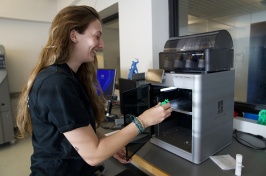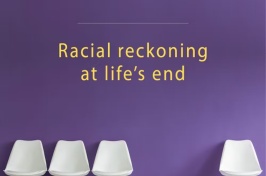
Shyla Gregory ‘17, like many college students, knows what it’s like to worry. Between classes, studying, a job and balancing relationships, she says, “We don’t realize how much we stress ... It takes years off your life. Just breathe.”
In professor Barbara White’s class Stressed Out: The Science and Nature of Human Stress, Gregory and more than 200 others learned that “Just breathe” mantra. The words appear in a mosaic the students created based on the prompt “What brings you happiness?” that instructor Peter Welch posed during a class session focused on art as therapy.
Each student received a small square of paper and crayons. They were asked to incorporate curves and lines already implanted in some of the squares into their art, just as Welch asked them to incorporate the mantra into their lives.
“Focusing on what makes you happy and then seeing how that connected to everyone else’s idea of happiness was incredible.”“Once they completed their square, I asked them to bring it to the front of the room, beginning with number one, so the mosaic was created in the classroom and ‘just breathe’ began to appear as more squares were added to the mosaic.” Welch says. “In that sense, it was a living, breathing piece of art.”
The exercise showcased how art reveals inner emotions and offers a healthy way to access and express feelings.
“Focusing on what makes you happy and then seeing how that connected to everyone else’s idea of happiness was incredible,” Gregory says. While many students drew suns (and even one king jellyfish from the cartoon “SpongeBob SquarePants”), Gregory drew a Celtic knot, a symbol for balancing spirit, body and mind. That balance is something White says those taking the class struggle with achieving.
“I have students who worry about money, about where their lives are going, about their social relationships. I have students who worry that they’re worrying too much,” White says. “I hope to teach them that most of the stuff we stress about isn’t worth the time and energy, and that we shouldn’t be burdened by what we perceive to be our negative qualities.”
Other class exercises include yoga and identifying the relationship between temperature and stress with special thermometers. All are designed to teach how worry affects the body physically, mentally and emotionally and can be applied to life outside the classroom.
White says she aspires to teach students how to channel fear and anxieties to help motivate rather than hinder, and to prove that those with worries are not alone.
In college, where social, personal and academic expectations add extra stress, White hopes to give students — who report high stress and feelings of isolation but lack knowledge about repercussions of long-term anxieties — tools to manage and appreciate pressure.
Gregory says now she understands herself on a deeper level. She has learned how to judge her own stress levels and how to take a moment to calm down. “I would recommend this class to every single person,” she says.
-
Written By:
Elizabeth Fiske '18 | Communications and Public Affairs | epf2002@wildcats.unh.edu



















































